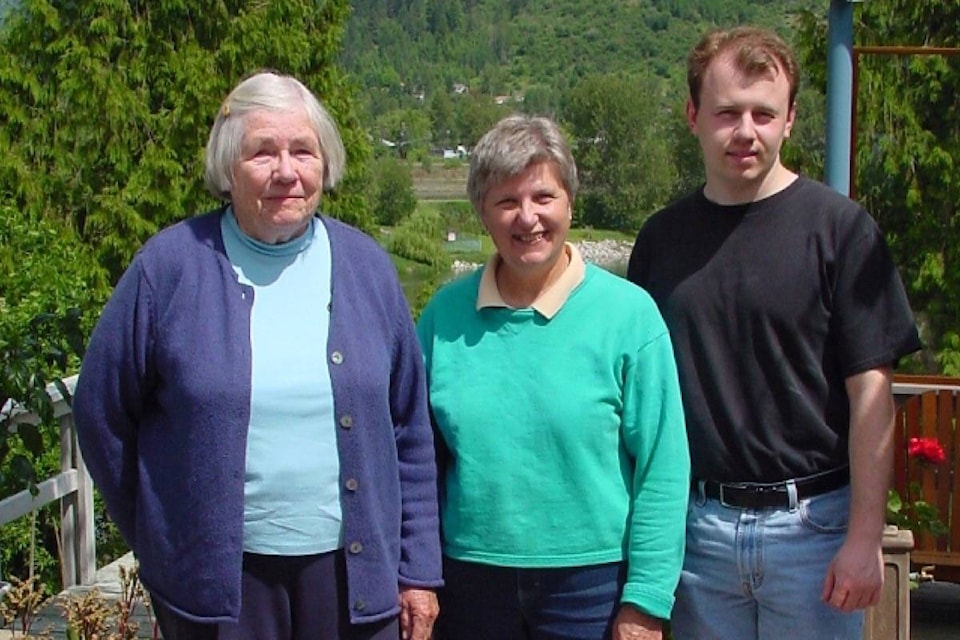Every so often I lie back in a recliner to study the sky. There is always something to attract attention, be it birds or cloud formations. When clouds are sparse, there are always contrails, left by planes as they jet across the sky.
Castlegar, a former crossroads of waterways and railways, and now at a crossroads of modern highways, is also at a crossroads in the skies above. We are located on the main east-west corridor, which offers a plane every half hour or so. Once in a while I catch a plane moving along a northeast-southwest line, most likely on the transcontinental flight between Seattle and Europe.
Our strategic location on the flight route across Canada supported the development of radio navigation towers at Krestova, as well as an emergency landing strip in 1938. The provisional landing strip was considered inadequate, and replaced by a better one at Ootischenia. This was expanded into an operational airport in 1947, when Canadian Pacific Airlines commenced service.
This was pointed out to Bryan Mahon, son of Castlegar founder Edward Mahon, when he was flying to Europe via Montreal on August 17, 1956. As an important manager at Boeing Aviation, he was invited to the cockpit by the flight crew:
“On the way between Vancouver and Calgary I spotted in the airplane the manager for the western region of Trans-Canada Airlines traveling as a passenger. I showed him my identity card. And right there, he invited me to the cockpit of the plane, and I could see the route through the pilot’s windows. The co-pilot pointed out to me the Castlegar airport when we were passing over it. This was very interesting for me because around 1900, my father had named the small city of Castlegar after the family house in Ireland which I will be visiting Sept. 7. I stayed with the pilot in the cockpit about two hours. The hostess brought us coffee and biscuits.”
As Bryan would find out when he came to visit with his family in 1972, his father’s city was totally unaware of how it was formed and how it had obtained its name, and much to his consternation, none of the people he approached seemed to be interested. It would take another 33 years for a new connection to be made with Bryan, and another visit.
That happened after Greg Nesteroff wrote to Bryan, having traced him to Mercer Island with the assistance of Eleanore Dempster, who had written a book on the Capilano Suspension Bridge, which Edward Mahon had once owned. Marolyn, now Bryan’s widow, travelled to Castlegar in May 2006 with Eleanore to meet with Greg and I. That meeting opened the door to a new understanding of our early history.
Marolyn returned to Castlegar several times thereafter, often in the company of her children and grandchildren. She was dedicated to telling Edward’s story and supported my work in that endeavour. She was also a great admirer of the natural walking trails that had been built in the local area, and having walked around Mount Rainier as a teenager, she favoured the natural, minimally developed trails. She was not very fond of pavement.
She witnessed subtle changes in our city as time went by. In the effort to reinvent ourselves, we dropped our ‘crossroads’ branding statement in favour of a new one that was suggestive of a fairyland, which left her puzzled. Edward’s street names had long ago been replaced by a non-evocative numbering system. It seemed Edward’s city was consciously turning its back on history, a trait that makes us unique in the wider region.
Having seen Edward’s endowments and accomplishments in North Vancouver, she found his Castlegar park lacking his vision in terms of formal organization of tree plantings, shrubs and flowerbeds. Most of it still looks like an area that had been previously degraded.
Marolyn is gone now, and I hope that we will wake up from our Happily-Ever-After Fantasyland, and return to a truer vision of greatness. North Vancouver council has recently dedicated $3.23 million to the completion of Edward’s Green Necklace greenway around the city. Perhaps we could catch a spark of their enthusiasm and follow his example, where formal parks as well as totally natural ones enhance what nature has provided. Millennium Park could be developed as a landscaped park that Edward would approve of. It will require generations of time to mature to its awesome grandeur. A place to uplift the spirit and provide pasture for the soul.
And most of the remainder of our pristine river shoreline should be left just as it is, a natural sanctuary for all the riparian wildlife that depends upon it. After all, our natural and free-flowing river is our greatest asset.
